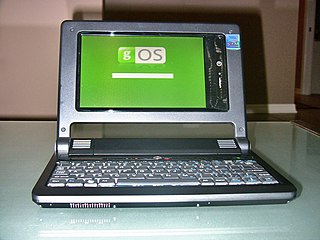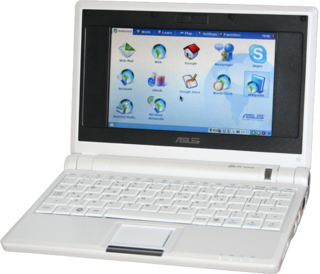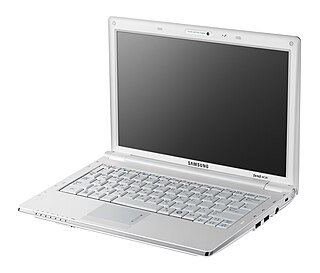
The Libretto is a line of subnotebook computers that was designed and produced by Toshiba. The line was distinguished by its combination of functionality and small size, squeezing a full Windows PC into a device the size of a paperback book. The first Libretto model, the Libretto 20, was released on April 17, 1996, with a volume of 821 cm3 (50.1 cu in) and weighing just 840 g (30 oz), making it by far, the world's smallest commercially available Windows PC at the time, and a trend the Libretto Range continued for many years. The original Libretto line was discontinued in Europe and the U.S. in 1999, but the production continued in Japan with the SS, FF and then the L series until 2002. The first L series Libretto was released on 18 May 2001 and the last just 11 Months later on 24 April 2002. Production of all Librettos ceased from 2002 until the release of the Libretto U100 in 2005.

An ultra-mobile PC, or ultra-mobile personal computer (UMPC), is a miniature version of a pen computer, a class of laptop whose specifications were launched by Microsoft and Intel in Spring 2006. Sony had already made a first attempt in this direction in 2004 with its Vaio U series, which was only sold in Asia. UMPCs are generally smaller than subnotebooks, have a TFT display measuring (diagonally) about 12.7 to 17.8 centimetres, are operated like tablet PCs using a touchscreen or a stylus, and can also have a physical keyboard. There is no clear boundary between subnotebooks and ultra-mobile PCs, but UMPCs commonly have major features not found in the common clamshell laptop design, such as small keys on either side of the screen, or a slide-out keyboard.

The NanoBook is an ultra-mobile PC reference design by VIA Technologies, Inc. It has a clamshell form factor, a 7-inch 800×480 touchscreen display, and a full-size keyboard. It weighs less than 850g and has a claimed battery life of up to 4.5 hours. It is based on the VIA VX700 chipset, featuring the VIA UniChrome Pro II IGP integrated graphics and powered by the 1.2-GHz VIA C7-M ultra low voltage processor. It includes up to 1GB DDR2 memory, a minimum 30-GB hard drive, 802.11g WiFi, Bluetooth and Ethernet support, as well as a 4-in-1 card reader, a DVI port and two USB 2.0 ports.

Asus Eee is a family of products by AsusTek Computer Inc. The product family began with the release of the Eee PC subnotebook in 2007; since then, the product family has diversified into a number of PC form factors. According to the company, the name Eee derives from "the three Es," an abbreviation of its advertising slogan for the device: "Easy to learn, Easy to work, Easy to play".

The ASUS Eee PC was a netbook computer line from Asus, and a part of the ASUS Eee product family. At the time of its introduction in late 2007, it was noted for its combination of a lightweight, Linux-based operating system, solid-state drive (SSD), and relatively low cost. Newer models added the options of Microsoft Windows operating system and rotating media hard disk drives (HDD), and initially retailed for up to 500 euros.

The Noahpad is a Netbook developed by the Taiwanese company E-Lead. This small laptop shares some similar characteristics with other Netbooks launched in 2007, like the ASUS Eee PC, the OLPC and the Classmate PC.
The Elonex ONE was a netbook computer marketed to the education sector by Elonex. The ONE's operating system was called Linos, based on Linux kernel 2.6.21, and the device had Wi-Fi connectivity, Ethernet networking, a solid-state hard drive, two USB ports and weighed less than 1 kg.

The ECS G10IL is a netbook computer designed by ECS. Using an Intel Atom N270 processor, it includes a built-in tri-band HSDPA and HSUPA, the "Super 3G". The notebook is available with Linux or Windows XP.

The A110 is a netbook computer by One. It is built on a reference design by Quanta Computer and was announced to run Linpus Linux. However, some or all of the first batch have actually been delivered with a modified Ubuntu Linux installed, using SquashFS to fit the system in the 2GB Flash memory.
These tables provide a comparison of netbooks.

The first netbook offering by Gigabyte, the M912, is a hybrid netvertible Tablet PC device, was released in 2008. It features an Intel Atom processor and comes preloaded with either Windows XP, Windows Vista or a customised Linux distribution. The hardware varies slightly depending on the OS chosen. The Linux Version for example does not include Bluetooth and has a lower resolution screen. Press accounts suggest that there may be significant heat and speed issues compared with other netbooks. Other criticisms focus on Gigabyte's choice to ship one variant with Windows Vista Home Basic, which lacks official Tablet PC support.

The Asus Eee Top is a touch screen all-in-one desktop computer designed by Asus and released in November 2008. Its motherboard employs Splashtop technology called "ExpressGate" by Asus.

HP TouchSmart is a series of tablet PC laptops and touchscreen all-in-one desktop computers designed by HP. It features various Intel or AMD processors and runs Windows Vista or Windows 7 as standard.
MSI Wind PC is a nettop counterpart to the MSI Wind Netbook. The MSI Wind PC is sold in Europe, Asia, and in the United States, barebones kits were available until Summer 2009, when desktop units also became available.

The Sony Vaio P series is a range of ultraportable subnotebook computers launched in January 2009.
The Dell Inspiron Mini Series is a line of subnotebook/netbook computers designed by Dell. The series was introduced in September 2008 amidst the growing popularity of low-cost netbook computers introduced by competitors.

The Samsung NC20 is a subnotebook / Netbook computer designed by Samsung. At the time of its introduction,, it was the first mainstream netbook to use the VIA Nano processor and the first to support the x86-64 instruction set. The 12.1" screen size is larger than typical for this class of ultra portable PC. Its most direct competitors are the Lenovo IdeaPad S12 and the MSI Wind U210.

The Acer AspireRevo was a line of nettop computers from Acer Inc., first released at the end of April 2009. It is one of the first desktop computers to pair the NVIDIA ION chipset with Intel's Atom CPU.

HP Mini is a former line of small computers categorized as netbooks manufactured by Hewlett-Packard. They either contained a custom version of Ubuntu Linux, Microsoft Windows XP Home Edition or Windows 7 Starter operating system. Like most netbooks, they were not built with CD/DVD drives. They were announced from mid-2007, and marketed from 2008 through 2012.

The IdeaPad S Series is a series of notebook computers launched by Lenovo in October 2008. The IdeaPad S10 was initially scheduled for launch in September, but its release was delayed in the United States until October.



















